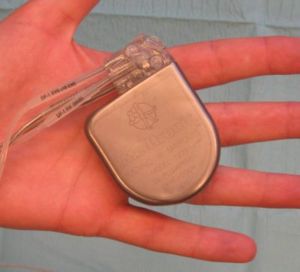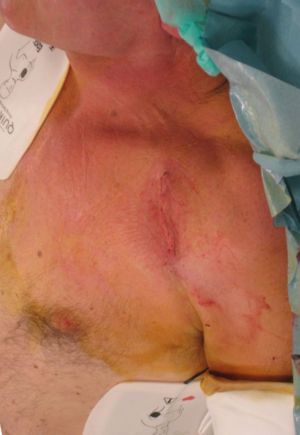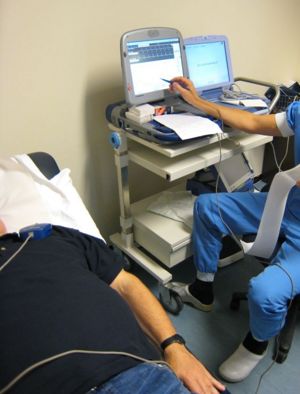ICD: Difference between revisions
mNo edit summary |
mNo edit summary |
||
| (6 intermediate revisions by the same user not shown) | |||
| Line 2: | Line 2: | ||
[[Image:ICD_wound.jpg|thumb|An ICD is usually implanted subcutaneously]] | [[Image:ICD_wound.jpg|thumb|An ICD is usually implanted subcutaneously]] | ||
[[Image:ICD_readout.jpg|thumb|The information stored in the ICD's memory can be read out using a coil that is put on the patients clothing near the ICD. Stored information includes battery life remaining and ICD shocks]] | [[Image:ICD_readout.jpg|thumb|The information stored in the ICD's memory can be read out using a coil that is put on the patients clothing near the ICD. Stored information includes battery life remaining and ICD shocks]] | ||
ICD (Implantable Cardioverter Defibrillator ): this device can detect and treat [[Ventricular Tachycardia]] and [[Ventricular Fibrillation]]. Usually the first treatment is anti-tachy pacing (pacing at a rate +- 10% above the ventricular rate in ventricular tachycardia, which can convert the rhythm to sinus rhythm). If this is not effective an defibrillator shock is delivered, usually with 16-36 Joules of energy. ICDs can save lives in patients who have a high risk of ventricular arrhythmias. All ICDs have optional pacemaker activity to treat bradycardias. New biventricular ICDs have 3 leads: an atrial lead, a left ventricular lead and a right ventricular lead. | ICD (Implantable Cardioverter Defibrillator ): this device can detect and treat [[Ventricular Tachycardia]] and [[Ventricular Fibrillation]]. Usually the first treatment is anti-tachy pacing (pacing at a rate +- 10% above the ventricular rate in ventricular tachycardia, which can convert the rhythm to sinus rhythm). If this is not effective an defibrillator shock is delivered, usually with 16-36 Joules of energy. ICDs can save lives in patients who have a high risk of ventricular arrhythmias. All ICDs have optional pacemaker activity to treat bradycardias. New biventricular ICDs have 3 leads: an atrial lead, a left ventricular lead and a right ventricular lead.<cite>Passman</cite><cite>DiMarco</cite> | ||
==A short history of ICD therapy== | ==A short history of ICD therapy== | ||
*1849 First graphical registration of VF<cite>Hoffa</cite> | |||
*1899 | *1899 First documented defibrillation of a dog with ventricular fibrillation (VF) in dogs.<cite>Prevost</cite> | ||
*1947 The thoracic surgeon Claude Beck saved the first human life by the successful use of cardiac defibrillation in a 14-year-old boy who developed VF during a thoracic surgical procedure and went on to achieve a full recovery.<cite>Beck</cite> | |||
*1973 Concept of implantable ICD<cite>Mirowski1</cite> | |||
*1980 First human implantation of an ICD<cite>Mirowski</cite> | |||
==References== | ==References== | ||
<biblio> | <biblio> | ||
# Prevost J, Batelli F. La mort par les courants electriques: courant alternative a bas voltage. J Physiol Path Gen. 1899; 1: 399–412. | #Hoffa Hoffa M,Ludwig C., Ztschrft Rat Med 1850; 9:107 | ||
#Prevost Prevost J, Batelli F. ''La mort par les courants electriques: courant alternative a bas voltage.'' J Physiol Path Gen. 1899; 1: 399–412. | |||
#Beck Beck C, Pritchard W, Heil H. ''Ventricular fibrillation of long duration abolished by electric shock.'' JAMA. 1947; 135: 985–986. | |||
#Mirowski pmid=6991948 | |||
#Mirowski1 pmid=4490731 | |||
#Passman Passman, Kadish. Circulation. 2007;116:561-571. | |||
#DiMarco pmid=14602883 | |||
</biblio> | </biblio> | ||
Latest revision as of 08:46, 31 July 2007
ICD (Implantable Cardioverter Defibrillator ): this device can detect and treat Ventricular Tachycardia and Ventricular Fibrillation. Usually the first treatment is anti-tachy pacing (pacing at a rate +- 10% above the ventricular rate in ventricular tachycardia, which can convert the rhythm to sinus rhythm). If this is not effective an defibrillator shock is delivered, usually with 16-36 Joules of energy. ICDs can save lives in patients who have a high risk of ventricular arrhythmias. All ICDs have optional pacemaker activity to treat bradycardias. New biventricular ICDs have 3 leads: an atrial lead, a left ventricular lead and a right ventricular lead.[1][2]
A short history of ICD therapy
- 1849 First graphical registration of VF[3]
- 1899 First documented defibrillation of a dog with ventricular fibrillation (VF) in dogs.[4]
- 1947 The thoracic surgeon Claude Beck saved the first human life by the successful use of cardiac defibrillation in a 14-year-old boy who developed VF during a thoracic surgical procedure and went on to achieve a full recovery.[5]
- 1973 Concept of implantable ICD[6]
- 1980 First human implantation of an ICD[7]
References
-
Passman, Kadish. Circulation. 2007;116:561-571.
- DiMarco JP. Implantable cardioverter-defibrillators. N Engl J Med. 2003 Nov 6;349(19):1836-47. DOI:10.1056/NEJMra035432 |
-
Hoffa M,Ludwig C., Ztschrft Rat Med 1850; 9:107
-
Prevost J, Batelli F. La mort par les courants electriques: courant alternative a bas voltage. J Physiol Path Gen. 1899; 1: 399–412.
-
Beck C, Pritchard W, Heil H. Ventricular fibrillation of long duration abolished by electric shock. JAMA. 1947; 135: 985–986.
- Mirowski M and Mower MM. Transvenous automatic defibrillator as an approach to prevention of sudden death from ventricular fibrillation. Heart Lung. 1973 Nov-Dec;2(6):867-9.
- Mirowski M, Reid PR, Mower MM, Watkins L, Gott VL, Schauble JF, Langer A, Heilman MS, Kolenik SA, Fischell RE, and Weisfeldt ML. Termination of malignant ventricular arrhythmias with an implanted automatic defibrillator in human beings. N Engl J Med. 1980 Aug 7;303(6):322-4. DOI:10.1056/NEJM198008073030607 |


